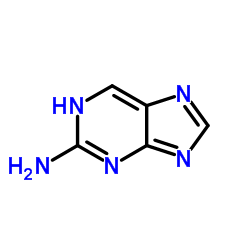2-Aminopurine

2-Aminopurine structure
|
Common Name | 2-Aminopurine | ||
|---|---|---|---|---|
| CAS Number | 452-06-2 | Molecular Weight | 135.127 | |
| Density | 1.9±0.1 g/cm3 | Boiling Point | 328.2±25.0 °C at 760 mmHg | |
| Molecular Formula | C5H5N5 | Melting Point | 280-282 °C(lit.) | |
| MSDS | Chinese USA | Flash Point | 152.3±23.2 °C | |
| Symbol |

GHS07 |
Signal Word | Warning | |
|
Site-specific fluorescence dynamics in an RNA 'thermometer' reveals the role of ribosome binding in its temperature-sensitive switch function.
Nucleic Acids Res. 43(1) , 493-503, (2015) RNA thermometers control the translation of several heat shock and virulence genes by their temperature-sensitive structural transitions. Changes in the structure and dynamics of MiniROSE RNA, which regulates translation in the temperature range of 20-45°C, w... |
|
|
Pro-inflammatory cytokine/chemokine production by reovirus treated melanoma cells is PKR/NF-κB mediated and supports innate and adaptive anti-tumour immune priming.
Mol. Cancer 10 , 20, (2011) As well as inducing direct oncolysis, reovirus treatment of melanoma is associated with activation of innate and adaptive anti-tumour immune responses.Here we characterise the effects of conditioned media from reovirus-infected, dying human melanoma cells (re... |
|
|
Ligand-induced evolution of intrinsic fluorescence and catalytic activity from cobalt ferrite nanoparticles.
ChemPhysChem 16 , 1627-34, (2015) To develop CoFe(2)O(4) as magneto-fluorescent nanoparticles (NPs) for biomedical applications, it would be advantageous to identify any intrinsic fluorescence of this important magnetic material by simply adjusting the surface chemistry of the NPs themselves.... |
|
|
CGP74514A enhances TRAIL-induced apoptosis in breast cancer cells by reducing X-linked inhibitor of apoptosis protein.
Anticancer Res. 34(7) , 3557-62, (2014) Despite the selectivity of Tumor necrosis factor Related Apoptosis-Inducing Ligand (TRAIL) for cancer cell killing activity, breast cancer cells are resistant to TRAIL-induced apoptosis for various reasons.From a functionally-characterized small-molecule data... |
|
|
Synthesis of 9,9'-[1,2-ethanediylbis(oxymethylene)]bis-2-amino-1,9-dihydro-6H-purin-6-one, an impurity of acyclovir.
Molecules 17(8) , 8735-41, (2012) The synthesis of 9,9'-[1,2-ethanediylbis(oxymethylene)]bis-2-amino-1,9-dihydro-6H-purin-6-one, a minor impurity of acyclovir, is described. Starting with commercial N-(9-acetyl-6-oxo-1H-purin-2-yl)acetamide, the process uses an acid catalysed phase transfer c... |
|
|
Argininosuccinate lyase is a potential therapeutic target in breast cancer.
Oncol. Rep. 34 , 3131-9, (2015) Arginine is a non-essential amino acid that modulates nitric oxide production and cancer homeostasis. In our previous study, we observed that blocking argininosuccinate lyase (ASL) attenuates tumor progression in liver cancer. However, the role of ASL in huma... |
|
|
2-Nitrophenol reduction promoted by S. putrefaciens 200 and biogenic ferrous iron: the role of different size-fractions of dissolved organic matter.
J. Hazard. Mater. 279 , 436-43, (2014) The reduction of nitroaromatic compounds (listed as a priority pollutant) in natural subsurface environments typically coexists with dissimilatory reduction of iron oxides effected by dissolved organic matter (DOM). Investigating the impact of the DOM that in... |
|
|
Cooperative base pair melting by helicase and polymerase positioned one nucleotide from each other.
Elife 4 , (2015) Leading strand DNA synthesis requires functional coupling between replicative helicase and DNA polymerase (DNAP) enzymes, but the structural and mechanistic basis of coupling is poorly understood. This study defines the precise positions of T7 helicase and T7... |
|
|
IL-10-dependent S100A8 gene induction in monocytes/macrophages by double-stranded RNA.
J. Immunol. 182 , 2258-2268, (2009) The S100 calcium-binding proteins S100A8 and S100A9 are elevated systemically in patients with viral infections. The S100A8-S100A9 complex facilitated viral replication in human CD4(+) T lymphocytes latently infected with HIV-1- and S100A8-induced HIV-1 trans... |
|
|
Novel role for the double-stranded RNA-activated protein kinase PKR: modulation of macrophage infection by the protozoan parasite Leishmania.
FASEB J. 24 , 617-626, (2010) The evolution of Leishmania infection depends on the balance between microbicidal and suppressor macrophage functions. Double-stranded RNA (dsRNA)-activated protein kinase R (PKR), a classic antiviral protein, is able to regulate a number of signaling pathway... |